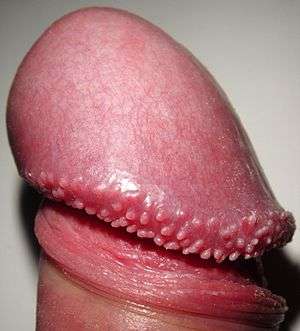Hirsuties coronae glandis
| Hirsuties coronae glandis | |
|---|---|
 | |
| Glans penis with hirsuties papillaris glandis | |
| Classification and external resources | |
| Specialty | Dermatology |
| ICD-10 | N48.89 |
| ICD-9-CM | 607.89 |
| eMedicine | article/1058826 |
Hirsuties coronae glandis (also known as "hirsutoid papillomas"[1] and "pearly penile papules")[1] are small protuberances that may form on the ridge of the glans of the human penis. They are a harmless anatomical variation. Though sometimes confused with HPV infection, the papules are not a sexually transmitted infection and are not contagious.
The papules appear as one or several rows of small, pearly or flesh-colored, smooth, dome-topped bumps situated circumferentially around the corona or sulcus of the glans. They may range in size from less than 1 mm to 3 mm.[2] As of 1999, different studies have produced estimates of incidence ranging from 8 to 48 percent of all men.[3] Studies suggest that it occurs more often on younger men and those who have not been circumcised.[4] One study found them in 33.3% of males who had not been circumcised and in 7.1% of circumcised males.[3]
Hirsuties coronae glandis are sometimes described as vestigial remnants of penile spines, sensitive features found in the same location in other primates. In species which retain the full expression of penile spines, the spines contribute to sexual pleasure and quicker orgasms.[5]
A similar expression, vestibular papillomatosis of the vulva or "hirsuties papillaris vulvae",[6] occurs in females and similarly can be misinterpreted as an outbreak of the HPV infection. Like hirsuties papillaris genitalis, it is a normal variation on human anatomy.[7]
Medical removal
While hirsuties papillaris genitalis pose no risk to a male's health, some men or their sexual partners may consider them aesthetically displeasing. There are several medical ways to remove them. Like any elective medical procedure, there is always some risk of unexpected consequences, so doctors advise against their removal unless they are causing a patient serious problems.[2]
One of the available treatments is performed by a dermatologist, using a CO2 laser to vaporise the papules. This normally takes only a few minutes to perform.[8] It is simple and does not normally require a hospital stay; discomfort should be minimal and the expected recovery time is 1 to two weeks. Another procedure involves electrosurgery performed with a hyfrecator and should take less than an hour to perform.[9]
Both procedures should be out-patient procedures if no complications arise.
Myths and misunderstandings
Although it is not related to any pathological condition, hirsuties papillaris genitalis is occasionally mistaken for HPV warts.[10] There are also home remedies for "curing" it.[2] Some of the "home remedies" found on the Internet and elsewhere use mild ointments or creams to soften the papules, but others are physically dangerous techniques for papule removal which can result in permanent genital mutilation. Rapini et al. advise that, since dermatologists have safe, effective ways to remove the papules if desired, home remedies involving corrosive substances or self-surgery should be avoided, since they can permanently damage sexual functioning. Rapini et al. further state that removal should only be performed by a physician using proven medical techniques.[1]
See also
Notes
- 1 2 3 Rapini, Ronald P.; Bolognia, Jean L.; Jorizzo, Joseph L. (2007). Dermatology: 2-Volume Set. St. Louis: Mosby. ISBN 1-4160-2999-0.
- 1 2 3 Richard Pattman, Michael Snow, Pauline Handy, Babiker Elawad Oxford handbook of genitourinary medicine, HIV, and AIDS, Volume 13
- 1 2 Brown, Clarence William (February 13, 2014). "Pearly Penile Papules: Epidemiology". Medscape. Retrieved 2014-03-08.
- ↑ Hogewoning JA, Bleeker MC, den Brule AJ, et al. (2003). "Pearly penile papules: Still no reason for uneasiness". J Am Acad Dermatol. 49 (1): 50–4. doi:10.1067/mjd.2003.420. PMID 12833007.
- ↑ "The real "junk" DNA". john hawks weblog.
- ↑ Moyal-Barracco, M; Leibowitch, M; Orth, G (1990). "Vestibular papillae of the vulva. Lack of evidence for human papillomavirus etiology". Archives of dermatology. 126 (12): 1594–8. doi:10.1001/archderm.1990.01670360058008. PMID 2175164.
- ↑ Colposcopy of the Vulva, Perineum and Anal Canal.gyncph.dk
- ↑ William Groff, (July 10, 2009) CO2 Laser Treats Pearly Penile Papules American Health & beauty Magazine
- ↑ "Pearly Penile Papules Removal". pearlypenilepapules.co.uk.
- ↑ Laura Pye (2009) Human papillomavirus, and vaccination. InnovAiT, Royal College of General Practitioners
References
- Sonnex C, Dockerty WG (November 1999). "Pearly penile papules: a common cause of concern". Int J STD AIDS. 10 (11): 726–7. doi:10.1258/0956462991913402. PMID 10563558. (subscription required (help)).
External links
| Wikimedia Commons has media related to Hirsuties papillaris genitalis. |
- DermAtlas—information and images
- Demonstration by animation of Pearly Penile Papules (video)